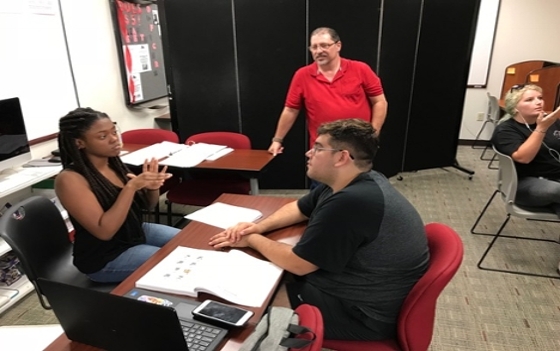History
Training Ground for Professionals
Lamar University's Department of Deaf Studies and Deaf Education is the third largest program in the U.S. that produces teachers and educational leaders who are Deaf (D/deaf, DeafBlind and Hard of Hearing) or hearing.
Lamar University has become a training ground for deaf education professionals who are Deaf or hearing, and has filled a critical need in our field to diversify the early childhood, K-12 and post-secondary workforce with diverse Deaf/hearing teachers and professors since the 1970s.

Where Our Graduates Work
Our graduates, both Deaf and hearing, work in programs in Texas and other states, as well as in Puerto Rico, China, South America and Saudi Arabia to provide educational programs for Deaf children, youth and adults.
DSDE History
- Past
1975
The program began in 1975 when Dr. Olen "Pete" Peterson, an audiologist, and Dr. Robert "Bob" Moulton, a speech-language pathologist and deaf educator initiated a Bachelor of Science degree program in communication disorders, and three Master of Science degrees: speech-language pathology, audiology and Deaf Education.
1978
In 1978, courses in American Sign Language replaced manual communication and manual codes of English and the department required its students to develop proficiency in the language of the Deaf community (American Sign Language) and be knowledgeable about Deaf culture.
With American Sign Language, Deaf culture and the Deaf Education curriculum, the Deaf Education Master of Science Degree continued to grow within the Communication Disorder program with both federal grants and Lamar University support.
1988 and the Present
Between 1988 and the present, the Deaf Education faculty obtained more than 11 million dollars in grants from the U.S. Department of Education and the National Science Foundation which both supported its students, and set up research and training programs. The Speech and Hearing Center where it was housed was remodeled and expanded and more faculty were hired.
Since 1988, the Master of Science program in Deaf Studies and Deaf Education has prepared more than 150 teachers of Deaf children, with more than 60% being Deaf teachers. In addition, the Doctoral program has prepared 69 leaders, of whom 60% are Deaf. These graduates work and have assumed leadership positions in universities and community colleges within Texas, the U.S. and internationally as well.
1994
In 1994, along with two additional tenure-tracked new faculty, a doctoral program, the Ed.D. was added.
The research developed by faculty and students in the Lamar University's Department of Deaf Studies and Deaf Education has contributed to the knowledge base in this field in areas such as:
- Reading
- Language
- Forensics
- American Sign Language studies
- American Sign Language assessment
- Bilingual education
- Technology
- Culture studies (Hispanic, Native American, African-American)
- Present
In 1995, based on the work of Dr. Stephen Nover and his colleagues, the Department of Deaf Studies and Deaf Education adopted the American Sign Language/English bilingual/bicultural philosophy and aimed to prepare pre-service teachers and leaders who work in preschool, K-12 and post-secondary programs serving Deaf children.
The American Sign Language/English bilingual curriculum permeates all three programs:
- B.A. in ASL Studies
- M.S. in Deaf Studies and Deaf Education
- Ed.D. in Deaf Studies and Deaf Education
Divided Into Two New Departments
Due to the rapid growth in student enrollment and the vision of Dr. Russ Schultz, dean of the College of Fine Arts and Communication, the Communication Disorder program was divided into two new departments in 2006, the Department of Speech and Hearing Sciences and the Department of Deaf Studies and Deaf Education.
In 2006, a new Bachelor of Arts degree was added in American Sign Language Studies. This undergraduate program enrolls about 120 students and prepares teachers of American Sign Language as a second language in public schools and sign language interpreters.
Lamar Only Teaches Sign Language as a Second Language
Lamar is the only program in Texas that prepares American Sign Language teachers who teach American Sign Language as a second language to hearing students.
- Future
Currently, the Department of Deaf Studies and Deaf Education is growing and taking on new challenges.
Facilities
The department has moved to the Communications Building to provide more space for classrooms, offices, and research labs.
Faculty
Our new faculty has invigorated our curriculum bringing their teaching and research expertise from Ohio State University and Gallaudet University to benefit our students with state-of-the-art teaching and research.
Please explore this website to read about our faculty, students and ongoing dissertation research.